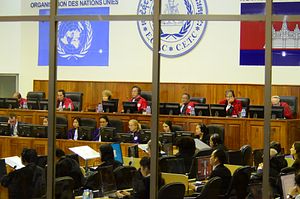While the pursuit of justice for the genocide that occurred under Cambodia’s brutal Khmer Rouge continues to be a challenging process legally, a more encouraging sign is the fact that a new generation of scholars are continuing to shed light on what happened so that the memory of that period is still kept alive.
The legal maneuvering at the Khmer Rouge Tribunal has continued without respite. Pol Pot’s former henchmen Nuon Chea and Khieu Samphan have launched an appeal against their genocide convictions, while a senior prosecutor has resigned.
Achieving victory at the appeals level in the UN-backed Extraordinary Chambers of the Courts in Cambodia (ECCC) has generally been unsuccessful, and in one case the convicted, Kaing Guek Eav – the commandant of the S21 torture and extermination camp – received a heavier sentence.
But the focus of the tribunal has shifted to the prosecution of lesser lights, which slaughtered about 2 million people through genocide, starvation and illness brought by forced labor amid slave-like conditions.
Despite the best efforts of international prosecutors and judges, success at this level has been difficult to come. The biggest issue is a split in the court between international and local judges over whether to proceed with the trials of Meas Muth, Im Chaem, Yim Tith and Ao An.
In late June, Judge Michael Bohlander from Germany resigned after differing from his Cambodian counterpart who claimed Yim Tith, a senior cadre in charge of the southwest zone, did not fall within the court’s jurisdiction.
A similar dispute resulted with Meas Muth, the former naval commander. The case of Im Chaem, a former district official, was closed after judges agreed they had no jurisdiction. She who claims to be a Christian, and now says: “My mind is fresh and open with blessings from God.”
All three cases are closed or likely to hang in legal limbo, going nowhere until the ECCC closes its doors.
Ao An worked in the Southwest zone and was sent to the Central zone where prisoners sleeping on a bamboo floor were bayoneted from
While the legal arena is stifled, there are other avenues emerging in determining what happened under Pol Pot between 1975 and 1979. This includes a fresh generation of scholars who emerged at a prestigious conference held, in Asia for the first time, by the International Association of Genocide Scholars (IAGS).
These scholars have the capacity to sit in future judgment on the tribunal and allegations of interference from the Cambodian side that has so far thwarted efforts to expand the ECCC mandate in finding justice.
Craig Etcheson, a former ECCC investigator and now a visiting scientist at Harvard’s T.H. Chan School of Public Health, said the conference covered manifold aspects of genocide studies.
“For me, however, far and away the most impressive aspect of the conference is the surprisingly large group of young Cambodian scholars who are doing genuinely cutting-edge research on the Cambodian genocide.
“They have the language, cultural and technological skills necessary to correct previous errors in Cambodian genocide scholarship, to uncover new nuance in what happened under the Khmer Rouge regime, and to take research on the topic into new and very creative directions,” he added.
And there is plenty of work. While many of the lesser lights in the Khmer Rouge will escape legal justice, their legacy will continue to be documented and the atrocities committed under their names destined for the history books.
Meas Muth was responsible for seizing foreign sailors plying the waters in the Gulf Siam. They were taken to S21, forced to sign-off on confessions and slaughtered. One was taken outside the gates of the camp, placed in a tire, doused with petrol and burnt alive.
Ao An was a district secretary in the Southwest zone where prisoners sleeping on a bamboo floor were bayoneted from below while thousands were worked to death or killed for working too slow.
Im Cheam allegedly oversaw the killing of 40,000 people at the notorious Phnom Trayoung security center and Spean Sreng worksite. Yim Tith, now a wealthy businessman, was a commander, and his charges included genocide.
There are hundreds of other Khmer Rouge loyalists living freely across Cambodia who deserve to be brought before the courts. Even if that may not be possible, documenting what they did and ensuring their names are never forgotten, at least, remains a very real prospect.
Luke Hunt can be followed on Twitter @lukeanthonyhunt.

































